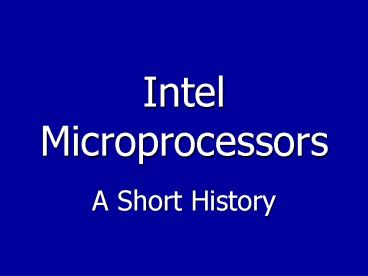Intel Microprocessors - PowerPoint PPT Presentation
1 / 14
Title:
Intel Microprocessors
Description:
The 4004 was Intel's first microprocessor. ... for a destination of the Starship Enterprise from the Star Trek television show. ... – PowerPoint PPT presentation
Number of Views:2311
Avg rating:3.0/5.0
Title: Intel Microprocessors
1
Intel Microprocessors
- A Short History
2
1971 4004 Microprocessor
- The 4004 was Intel's first microprocessor.
- This breakthrough invention powered the Busicom
calculator and paved the way for embedding
intelligence in inanimate objects as well as the
personal computer.
3
1972 8008 Microprocessor
- The 8008 was twice as powerful as the 4004.
- According to the magazine Radio Electronics, Don
Lancaster, a dedicated computer hobbyist, used
the 8008 to create a predecessor to the first
personal computer, a device Radio Electronics
dubbed a "TV typewriter." It was used as a dumb
terminal.
4
1974 8080 Microprocessor
- The 8080 became the brains of the first personal
computer--the Altair, allegedly named for a
destination of the Starship Enterprise from the
Star Trek television show. - Computer hobbyists could purchase a kit for the
Altair for 395. - Within months, it sold tens of thousands,
creating the first PC back orders in history.
5
1978 8086-8088 Microprocessor
- The sale of the 8088 to IBM's new personal
computer division made it the brains of IBM's
new hit product--the IBM PC. - The 8088's success propelled Intel into the ranks
of the Fortune 500, and Fortune magazine named
the company one of the "Business Triumphs of the
Seventies."
6
1982 286 Microprocessor
- The 286, also known as the 80286, was the first
Intel processor that could run all the software
written for its predecessor. - This software compatibility remains a hallmark of
Intel's family of microprocessors. - Within 6 years of it release, there were an
estimated 15 million 286-based personal computers
installed around the world.
7
1985 Intel 386(TM) Microprocessor
- The Intel 386TM microprocessor featured 275,000
transistors--more than 100times as many as the
original 4004. - It was a 32-bit chip and was "multi tasking,"
meaning it could run multiple programs at the
same time.
8
1989 Intel 486(TM) DX CPU
- The 486TM generation really allowed the shift
from command-level computing into point-and-click
computing. - The Intel 486TM processor was the first to offer
a built-in math coprocessor, which speeds up
computing because it offers complex math
functions from the central processor.
9
1993 Pentium Processor
- The Pentium processor allowed computers to more
easily incorporate "real world" data such as
speech, sound, handwriting and photographic
images. - The name Pentium, mentioned in the comics and on
television talk shows, became a household word
soon after introduction.
10
1995 Pentium Pro Processor
- Released in the fall of 1995 the Pentium Pro
processor is designed to fuel 32-bit server and
workstation-level applications, enabling fast
computer-aided design, mechanical engineering and
scientific computation. - Each Pentium Pro processor is packaged together
with a second speed-enhancing cache memory chip. - The powerful Pentium Pro processor boasts 5.5
million transistors.
11
1997 Pentium II Processor
- The 7.5 million-transistor Pentium II processor
incorporates Intel MMXTM technology, which is
designed specifically to process video, audio and
graphics data efficiently. - It is packaged along with a high-speed cache
memory chip in an innovative Single Edge Contact
(S.E.C.) cartridge that connects to a motherboard
via a single edge connector, as opposed to
multiple pins. - With this chip, PC users can capture, edit and
share digital photos with friends and family via
the Internet edit and add text, music or
between-scene transitions to home movies and,
with a video phone, send video over standard
phone lines and the Internet.
12
Where to from here?
13
Moore's Law
- Gordon Moore once observed that the speed and
power of microprocessors seems to double every 12
to 18 months. This trend has held true for the
past 20 years and is showing no sign of slowing
down. - What does this mean for the future of computing?
What other technologies can you think of which
get faster and more powerful every year, and yet
also get cheaper and more affordable!
14
?? ???
- A Short History of the Intel series of
Microprocessors

